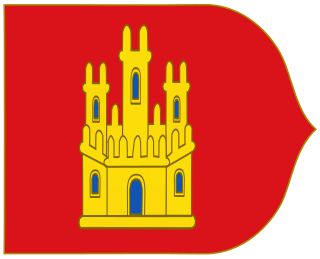The 920s decade ran from January 1, 920, to December 31, 929.
The 1030s was a decade of the Julian Calendar which began on January 1, 1030, and ended on December 31, 1039.

The taifas were the independent Muslim principalities and kingdoms of the Iberian Peninsula, referred to by Muslims as al-Andalus, that emerged from the decline and fall of the Umayyad Caliphate of Córdoba between 1009 and 1031. They were a recurring feature of al-Andalus history.

The Kingdom of Castile was a polity in the Iberian Peninsula during the Middle Ages. It traces its origins to the 9th-century County of Castile, an eastern frontier lordship of the Kingdom of León. During the 10th century, the Castilian counts increased their autonomy, but it was not until 1065 that it was separated from León and became a kingdom in its own right. Between 1072 and 1157, it was again united with León, and after 1230, this union became permanent. Throughout this period, the Castilian kings made extensive conquests in southern Iberia at the expense of the Islamic principalities. The Kingdoms of Castile and of León, with their southern acquisitions, came to be known collectively as the Crown of Castile, a term that also came to encompass overseas expansion.

Spain in the Middle Ages is a period in the history of Spain that began in the 5th century following the fall of the Western Roman Empire and ended with the beginning of the early modern period in 1492.
A petty kingdom is a kingdom described as minor or "petty" by contrast to an empire or unified kingdom that either preceded or succeeded it. Alternatively, a petty kingdom would be a minor kingdom in the immediate vicinity of larger kingdoms, such as the medieval Kingdom of Mann and the Isles relative to the kingdoms of Scotland or England or the Viking kingdoms of Scandinavia.
This is a timeline of notable events during the period of Muslim presence in Iberia, starting with the Umayyad conquest in the 8th century.

Marvão is a municipality in Portalegre District in Portugal. The population in 2020 was 2,972, in an area of 154.90 km2. The present Mayor is Luís Vitorino, elected by the Social Democratic Party. The municipal holiday is September 8.

The Kūra was one of the territorial demarcations into which al-Andalus, the ancient Islamic Iberian Peninsula, was divided during the Emirate and Caliphate of Córdoba. It coexisted with another territorial demarcation called March ("thagr"), which overlapped the Kūra in the areas bordering the Christian kingdoms. Both underpinned the al-Andalus territorial organization during the aforementioned periods.
This page is based on this
Wikipedia article Text is available under the
CC BY-SA 4.0 license; additional terms may apply.
Images, videos and audio are available under their respective licenses.




